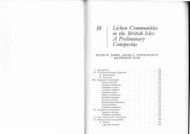Create successful ePaper yourself
Turn your PDF publications into a flip-book with our unique Google optimized e-Paper software.
The lichen species are for the most part<br />
white-gray to bluish-gray, greenish-gray, or<br />
yellow-greenish, rarely brown, yellow or orange<br />
colored. Although the color <strong>of</strong> the thallus is an<br />
important character, the proper specification <strong>of</strong><br />
thallus color is problematic. The lichen colors<br />
are frequently difficult to describe. At first the<br />
practice was to show to the reader a key little by<br />
little, whatever he was to understand under many<br />
color descriptions. Here the aid <strong>of</strong> color photos<br />
is a way around the deficiency <strong>of</strong> our language.<br />
Thus documenting a picture <strong>of</strong> Parmelia<br />
caperata or the beard lichen Usnea, it becomes<br />
understood what blue-greenish to<br />
yellow-greenish is in lichens, while the mere<br />
color description without picture documentation<br />
always leads to further misunderstanding.<br />
3.2.2 Structure and Organs <strong>of</strong> the Thallus<br />
Growth Forms<br />
Three main types <strong>of</strong> growth forms <strong>of</strong> lichens are<br />
described: crustose lichens with pure crustose<br />
thallus, foliose lichens with leaf-like, ± lobed<br />
thallus and fruticose lichens with shrubby to<br />
filamentous thallus. Between foliose and<br />
crustose lichens are intermediate forms with<br />
squamulose thallus and such crustose lichens,<br />
whose margins are clearly lobed. These crude<br />
divisions do not do justice to the majority <strong>of</strong> the<br />
forms <strong>of</strong> the lichens. They are however very<br />
useful for a first response. The more precise<br />
characterization or the growth form arises from<br />
the preparation <strong>of</strong> key parts. The group <strong>of</strong><br />
gelatinous lichens is characterized by the<br />
gelatinous consistency <strong>of</strong> the thallus (in the moist<br />
condition swelling gelatin-like); they can include<br />
various growth forms.<br />
Especially in the level <strong>of</strong> organization the<br />
crustose lichens are differentiated into many<br />
types <strong>of</strong> thallus forms, whereby above all their<br />
position is accepted on the degree <strong>of</strong> division <strong>of</strong><br />
the thallus and upon nature <strong>of</strong> the upper surface.<br />
Organization and Nature <strong>of</strong> the Upper<br />
Surface <strong>of</strong> the Thallus<br />
The upper surface <strong>of</strong> the foliose and fruticose<br />
lichens is – apart from the occurrence <strong>of</strong> isidia<br />
and soralia (see below) – smooth to rugose or<br />
from time to time weakly organized raised<br />
ridges. In many crustose lichens the thallus is<br />
cracked or subdivided into ± separated areoles;<br />
it may even consist or more or less closely<br />
crowded to scattered granules or sometimes<br />
completely mealy disintegrate. One speaks <strong>of</strong> a<br />
coralloid thallus when it is made up <strong>of</strong> elongate<br />
branched “granules.”<br />
Organization <strong>of</strong> the Thallus <strong>of</strong> Crustose <strong>Lichens</strong><br />
Egg-shaped, varnish-like, or membranous<br />
(not or scarcely cracked)<br />
Cracked<br />
Cracked areolate (reticulate cracked, thereby<br />
consisting <strong>of</strong> areas, area flat)<br />
Areolate (clearly separate areas)<br />
Warty areolate (Areoles convex)<br />
Squamulose (Areoles isolated, in the form <strong>of</strong><br />
± overlapping other areoles, the edges <strong>of</strong>ten<br />
crenate or lobed, usually raised from the<br />
substrate at the edges; if squamules more<br />
strongly divided <strong>of</strong> clearly erect: crossing over to<br />
“small foliose”)<br />
Upper Surface Condition <strong>of</strong> the Thallus <strong>of</strong><br />
Crustose <strong>Lichens</strong><br />
Mealy (very finely granular, “dusty”; when<br />
the upper surface is totally disintegrated it is<br />
called “leprose”)<br />
Granular (finely or coarse granular)<br />
Warty (Thallus uneven, unevenness warty<br />
convex)<br />
Wrinkled (Thallus irregularly uneven)<br />
Coralloid (<strong>of</strong> coral-like branched granules)<br />
Smooth<br />
Soralia and Isidia<br />
The soralia and isidia are among the most<br />
important diagnostic organs <strong>of</strong> the lichen thallus.<br />
They serve for vegetative reproduction.<br />
Existence and form <strong>of</strong> soralia and isidia are<br />
species specific characters.<br />
Isidia are usually simple peg or clavate form<br />
to coralloid branched or even almost spherical<br />
outgrowths <strong>of</strong> the upper side (see illustration),<br />
they are easily broken <strong>of</strong>f and may grow into<br />
young lichens. They are generally colored<br />
similar to the thallus and are even anatomically<br />
not basically constructed other than the thallus<br />
from which they are an outgrowth.<br />
Soralia are a somewhat mealy, usually whitish<br />
to greenish-gray outgrowth <strong>of</strong> the thallus, which<br />
9





